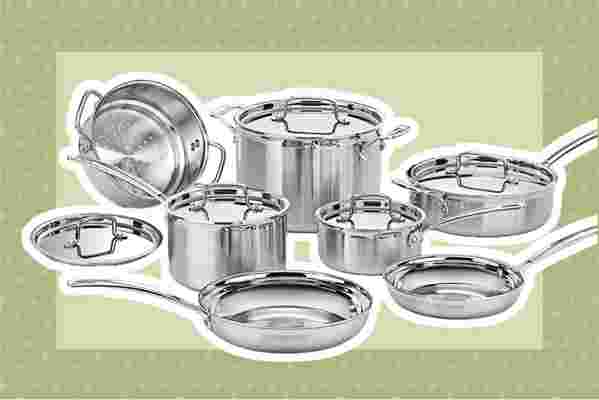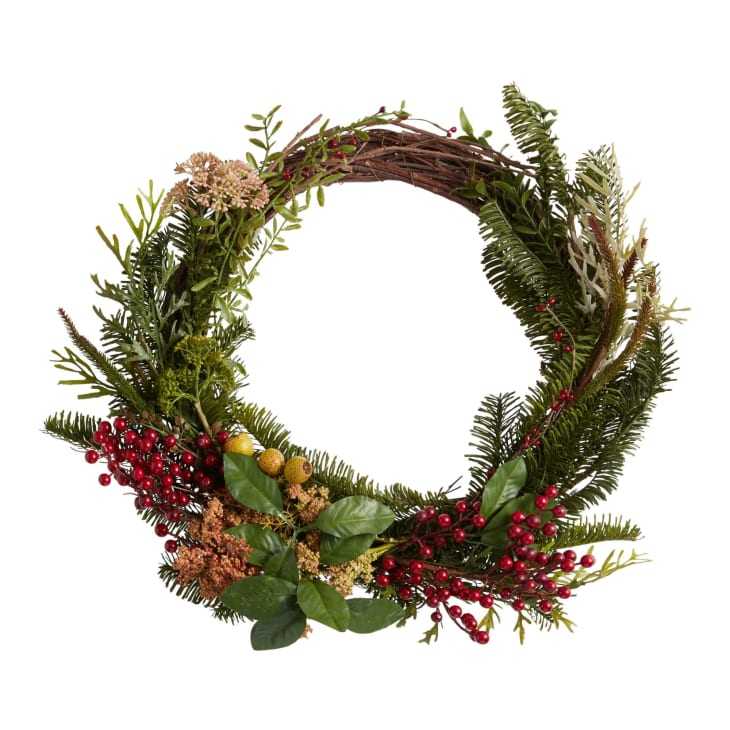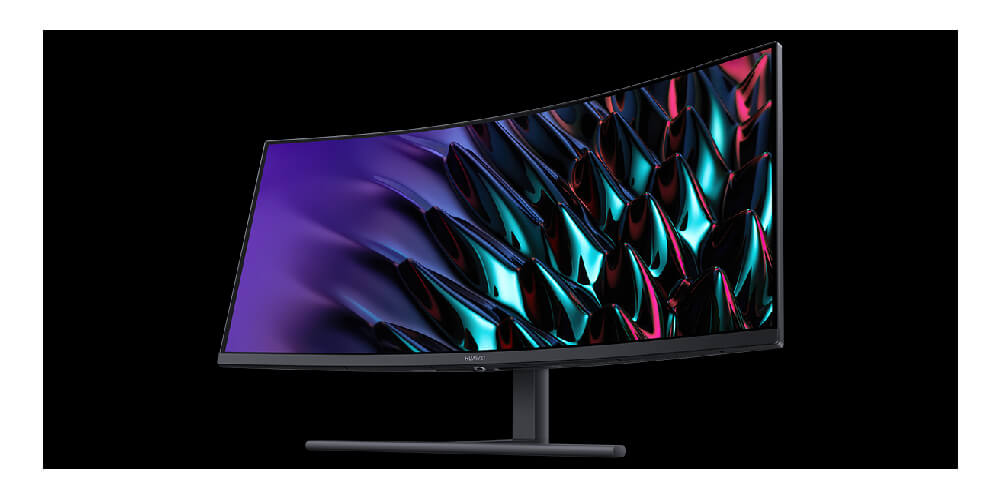We independently research, test, review, and recommend the best products—learn more about our process. If you buy something through our links, we may earn a commission.

Read on for our picks of the best cookware sets for your kitchen, according to our Lab testing.
When selecting the perfect set, it’s important to consider what you cook and in what quantities. A small frying pan may be perfect for a single person, but much less useful for a family. If a set is almost perfect, but is missing a piece, most manufacturers sell open stock cookware, so you can get that huge stock pot or grill pan you’ve been coveting. Keep in mind that lids count as pieces, and some sets include inexpensive extras, like spoons and spatulas that add to the piece count. You'll also want to decide on what material suits your needs best, so we've included a wide array for you to peruse, from classic stainless steel to nonstick aluminum and everything between.
We took a dozen top-rated cookware sets and tested them alongside each other in our product testing Lab to see how they really perform, making notes on their heating capabilities, comfort and maneuverability, and nonstick qualities. From frying eggs to simmering tomato sauce and browning chicken, we wanted to see how these sets lived up to their reputations, and because we know it's important to see how the pans perform in a real-life setting, we also sent them to our experienced food writers and editors for home testing .
When you're searching for the best cookware to outfit your kitchen, there are some advantages to buying a complete set. First, a set can be less expensive than buying individual pieces, so you’ll save money. Second, different types of cookware can behave differently on the stove, but when all your cookware is the same, you’ll be familiar with how they heat up and respond to temperature changes. And, of course, having a matching set will appeal to anyone who appreciates the visual harmony of uniform cookware on the stove.
"Since the material is oven safe to 400 degrees, you can use the cookware in the oven to finish your steak, and you can use the frying pans and the deep skillet for impromptu baking when you can’t find an appropriate pan for your emergency brownie craving." — Donna Currie , Product Tester
It is recommended that you wash these pieces by hand, keeping in mind the care required to maintain the nonstick surface . While the coating held up for our reviewer during her home testing period, she did notice that it was less effective over time, as is typical with most nonstick cookware.
In our Lab, we found this set to have excellent nonstick performance with its ceramic coating. A fried egg cooked quickly and slid off the pan easily. It was easy to brown chicken because of how efficiently the pans conduct heat, however, that meant that they also tend to run hot, which could potentially be a problem for foods that require slower, even heating, like long braises or stews. On the plus side, these pans are fairly lightweight and easy to maneuver, and would work well for someone who wants an affordable, well-curated set made with ceramic nonstick. You'll just have to be careful with sharp utensils, as they could damage the slick coating,
This set includes both 8- and 10-inch sauté pans, 1.5- and 3-quart saucepans with lids, a 3-quart deep sauté pan with lid, and a 6-quart Dutch oven with lid. Made from hard-anodized aluminum, the cookware is responsive to heat changes while the stainless steel handles stay cool during cooking. The included lids are glass, so you can check on the food without releasing the heat, and the handles are generously sized, so they’re easy to grab and hold.
"This set has really superior nonstick. We used no oil when cooking chicken and could easily glide the egg around the frying pan." — Felisia Tan, Test Kitchen Assistant
Our Lab tests showed that these pans required little to no oil for cooking, thanks to their excellent nonstick performance. The pans are super light, which is a double-edged sword: They heat up very quickly, which means you'll have to be mindful of controlling your burners so you don't accidentally over-brown or burn your food. We found the heat distribution to be good, just not great—our infrared thermometer detected some cold and hot spots—but when it comes to cooking sauces or stews, giving the pan's contents a stir should help alleviate some of the temperature disparity. In all, these pieces work better than a couple of other sets we tested at a similar price point.
Finding a balance of performance and value can be challenging, but this set from GreenPan is a clear winner when it comes to cookware that works well and won't break the bank. Featuring a 9.5-inch frying pan, 11-inch frying pan with lid, 1.5-quart saucepan with pour spouts, 3-quart sauté pan with lid, nylon and wood solid turner, and nylon and wood slotted spoon, you'll have everything you need to get cooking.
This 10-piece set includes an 8-inch skillet, 10-inch skillet, 2-quart saucepan with lid, 3-quart saucepan with lid, 3-quart deep sauté pan with lid, and 6-quart stockpot with lid. Sturdy, riveted stainless steel handles give you easy handling, and the entire pot is ovenproof up to 500 degrees. Hand washing is required for these gorgeous pieces, and our Lab tester noted that some additional upkeep is required if you prefer a shiny look versus the patina finish that will develop over time.
During our Lab tests, we found that this set excels in heat distribution. During our tomato sauce test, it began to bubble evenly around the diameter of the saucepan and developed an even simmer throughout after a few minutes. Because of the copper, our infrared thermometer detected consistent temperature through the bottom and center of the pan while the walls stayed a bit cooler. Though the frying pans require oil to make a fried egg without sticking, the resulting egg was delightfully even and beautifully cooked.
The hammered copper exterior of this classic French-style cookware set from Lagostina is absolutely gorgeous to look at, but it also serves a greater purpose: Copper heats five times better than cast iron and up to twenty times better than stainless steel. This exceptional heat conduction spreads heat faster and more evenly than other types of material, giving you greater responsiveness when trying to control the temperature of your pan.
"If you like nonstick, but worry that the finish won't last, this might change your mind. This set is very versatile and amazing for high-heat cooking." — Collier Sutter , Food and Drink Review Editor
Cleaning the pans is pretty effortless. While hand washing is usually recommended for nonstick cookware, the extra-tough finish on these pieces doesn't require special care. You can simply place them in the dishwasher.
During testing in The Lab, we enjoyed how versatile these pans are. Unlike traditional nonstick, they can be used on high heat, providing great, even heating on an induction burner (but slightly less even heating on other types of stoves). The handles are less slippery to hold since they are made from brushed metal versus polished stainless steel. The only drawback we noticed was that the frying pans don't have a sloped edge, requiring you to use your spatula to gently nudge your eggs onto your plate instead of just tipping them out.
If you love nonstick pans, but don't like having to be careful with their coating, you'll enjoy the extra durable finish on this set from Ninja. Made from hard-anodized aluminum, these pieces promise to never chip, flake, or stick and also hold up to metal utensils and aggressive scrubbing. In this set, you get 8-inch and 10.25-inch frying pans, a 2.5-quart saucepan, 3-quart sauté pan, and a 6.5-quart stockpot, plus glass lids. All of the pieces are oven safe up to 500 degrees and can be used on any stovetop.
"If you are looking for a cookware set and are torn between stainless steel and nonstick, this is it. Some tasks are best left to a nonstick pan, and with the Sardel, you've got options." — Collier Sutter , Food and Drink Review Editor
Cleaning this set was incredibly easy—our testers were able to clean the nonstick pieces in 20 seconds by hand, and the stainless steel pieces can go right into the dishwasher. If for any reason you don't love this set, you can return it for free within 30 days or take advantage of the limited lifetime warranty.
In our Lab tests, the five-ply construction demonstrated exceptional heat distribution, creating beautifully seared chicken and allowing for excellent fried eggs . We found that the pieces from this set were slightly lighter than similar five-ply cookware, making them easier to maneuver and transport. The slightly flared lips on the pots and pans minimize dripping to aid in keeping your kitchen neat while cooking.
Sardel joins the ranks of new cookware startups that are grabbing people's attention with their well-constructed pots and pans. The seven pieces in this classically designed set are all made in Italy and have two layers of stainless steel surrounding a three-layer aluminum core, giving you even heat distribution and quality that should last a lifetime. The set includes five lids.
"Caraway really thought everything out with the overall design. All pots and pan lids in the set sit snug, locking in moisture, while also equipped with a small hole to allow steam to escape and not over-pressurize. Plus, one lid fits on both the frying pan and Dutch oven." — Collier Sutter , Food and Drink Review Editor
Unlike other cookware sets on the market, this one comes with four magnetic pan racks and a canvas lid holder that can be attached to the inside of your cabinets for convenient storage . They are oven- and dishwasher-safe, although hand washing is recommended to keep them looking their best (most foods will glide off with a little soap and warm water).
In our Lab tests, Caraway proved that it was more than just aesthetically pleasing. These pieces displayed controlled and even heat distribution, giving a subtle sear and gentle buildup of color without scorching. The nonstick surface is perfect for evenly cooking eggs without sticking, and it also made cleanup seamless. The pots and pans are generously sized and perfect for large-batch recipes, though we do wish there were one more small frying pan included for quick, small tasks, like frying an egg or two.
This seven-piece cookware set from direct-to-consumer brand Caraway is the perfect blend of performance and design. The selection is thoughtfully curated, and each set is available in a variety of stylish hues with a modern silhouette that looks great on the stovetop. Included are a 10.5-inch fry pan, a 4.5-quart sauté pan with lid, a 3-quart saucepan with lid, and a 6.5-inch Dutch oven with lid—all compatible with any cooktop, including induction.
"I loved that I could still touch the handles on both sides without burning my hands—even after 15 minutes heating up on the stovetop." — Collier Sutter , Food and Drink Review Editor
This set is heat safe up to 600 degrees, making it easy to go from stovetop to oven or broiler. The pieces are also compatible with induction stoves and can withstand nearly any type of kitchen utensil without worrying you'll scratch the finish. Cleaning up is simple, as you can hand wash this cookware or place them into the dishwasher. While this set is definitely not cheap, you get what you pay for with All-Clad—it's a set of cookware you won't have to replace for years, if ever.
In our Lab, we determined these pans to be excellent for high-heat cooking, like searing meats and sautéing vegetables. Though they tend to concentrate heat in the center at first, it eventually spreads to the edges of the pan and provides steady, even heating. We did notice a bit of scorching while cooking tomato sauce over a medium setting, but gently stirring every so often should help avoid any hot spots as the pan heats up.
When it comes to high-quality cookware, All-Clad has built a reputation of trust among amateur and professional cooks alike. The d5 series is made of five alternating layers of stainless steel and aluminum for durability and optimum heat distribution, and is built to last. Included in this set are an 8- and 10-inch fry pan, 1.5- and 3-quart saucepans with lid, a 3-quart lidded sauté pan, and a 5.5-quart Dutch oven with lid.
Made of stainless steel with an aluminum core, they are induction compatible , oven safe to 550 degrees, and dishwasher safe for easy cleaning. The long handles stay comfortably cool during cooking and have hanging holes for storage, but our tester did caution that the side loop handles can get quite hot.
Experienced cooks will love this high-quality set of stainless steel cookware, which includes both a 1.5- and 3-quart saucepan, 8- and 10-inch open skillets, a 3.5-quart sauté pan, an 8-quart stockpot, and a steamer insert. Everything but the open skillets and the steamer insert come with lids. Our tester found the price to be "affordable considering the quality and number of useful pieces you get."
Final Verdict The Cuisinart Multiclad Pro Stainless Steel 12-Piece Cookware Set is our top choice for overall design, performance, and versatility. Looking for nonstick? You can't go wrong with the Caraway Ceramic Cookware Set, which offers sleek, modern design paired with top-notch performance.
The Spruce Eats / Brianna Gilmartin
How We Tested
Our editors spent weeks researching the best cookware sets and developing a standardized methodology against which to test them, and then took an additional week putting each appliance through its paces in our Lab's dedicated test kitchen.
Other Options We Tested
T-Fal Professional Nonstick 12-Piece Cookware Set (view at Amazon): While we've included this affordable set on our recommended list in the past, when compared with other similarly priced sets, it fell short. It doesn't retain heat as well as others, yet it seems much more susceptible to burning food—it was one of the only pans that started to smoke when making chicken in our Lab test. While T-Fal claims the pans are oven safe, we felt we had to pull it out of the oven as it started to smell strongly of plastic. The biggest deal breaker was that the bottom of the frying pan wasn't level, causing eggs to run towards the outer edges instead of sitting in the middle for even cooking.
Anolon SmartStack 10-Piece Cookware Set (view at Amazon): We left this set off our list because we noted a pretty uneven distribution of heat, which is a non-starter when it comes to cookware we stand behind. Though the material of these pans is thick and sturdy like the Caraway set, it heats quickly, but doesn't retain it, meaning you'll spend a lot more energy trying to keep your pans at temperature. During our Lab tests, it took longer to brown chicken than other brands, signifying a significant loss of heat as we waited for the ideal golden brown sear. On the upside, this set is comfortable to grip and easy to clean, but we feel there are better sets to be had at a similar price point.
Le Creuset Enameled Cast Iron 10-Piece Cookware Set (view at Amazon): We can't emphasize enough how much we love Le Creuset's cookware for even heat distribution and retention, but there are a few reasons why we omitted this set from our list. These pieces are super heavy and lend themselves best to certain tasks: high-heat searing and slow braising. For any other application—sautéing, boiling, making eggs—they're cumbersome, and there are other pieces of cookware that would work better. Because there are no lips on the pots and pans, they tend to get messy when pouring, as well, and they can be a bit stubborn to clean.
Cook N Home 12-Piece Stainless Steel Cookware Set (view at Amazon): While this is a super affordable pick, it doesn't include a frying pan, which is disappointing. You would have to purchase one separately, which doesn't seem practical if you want an all-in-one set. Our tests found that these pieces were very light and made with less-substantial material, which might make them more susceptible to damage and wear. On the plus side, they heated fairly evenly and could work for someone who is looking for an inexpensive set that they don't mind replacing eventually or someone who doesn't cook very often, but wants a full set on hand for when they do.
What To Look for in a Cookware Set
The Spruce Eats / Donna Currie
Material
Material is the first thing to consider when buying cookware since it affects both the price and the performance. While there are some cookware pieces made from clay or stovetop-safe ceramic materials, those tend to be specialty items rather than everyday cookware. Most cookware is made from some type of metal, with stainless steel, aluminum, and copper being the most common. While some cookware is made entirely from one type of metal, it’s not unusual to find cookware made from two or more materials.
The type of material the cookware is made from will dictate the way it's maintained. Some materials are more finicky than others, so while you might be able to toss some pieces in the dishwasher, others will need to be hand-washed. When it comes to cookware performance, different metals react differently when heated. From copper, which is super responsive, to cast iron that retains heat extremely well, each metal has its own special heating property.
The Spruce Eats / Donna Currie
Responsive metals gain and lose heat rapidly as you adjust the stove temperature. That responsiveness is desirable when cooking foods that can overcook quickly, like homemade crepes. It’s also useful for making jam or candy when it’s important to stop the cooking process at a specific temperature. Cast iron retains heat well, which means that it stays hot for a long time, even after the stove is turned off, and it also heats evenly, so you won’t get hot spots above the burners. Stainless steel and aluminum fall between copper and cast iron in terms of heat retention and responsiveness.
Coatings
Nonstick interior coatings prevent your eggs from sticking and make cleaning easier, while uncoated cookware tends to be better for searing meats and for handling high heat on the stove and in the oven. Some cookware has an exterior coating, which tends to be more decorative than functional. While anodizing isn’t technically a coating, it creates a hard outer surface on aluminum cookware that looks attractive and resists stains and corrosion. Cast iron cookware often has an enameled coating so it doesn’t need seasoning the way that uncoated cast iron does. Coated cast iron is resistant to corrosion and can handle acidic foods with ease. The downside to any coating is that it can be damaged, which can render the pan useless.
The Spruce Eats / Donna Currie
Size
When it comes to cookware, size always makes a big difference. A small frying pan is great for cooking one or two eggs, while a large stockpot is exactly what you need for cooking large batches of soup stock. There’s no right or wrong answer when it comes to the perfect size for a piece of cookware. It just depends on how many people you're trying to cook for and how much you want to make at one time. While some might prefer small cookware for individual meals, others might love large cookware, so they can cook ahead and freeze meals.
Shape
There are a huge variety of pots in different shapes, often for specific uses, like crepe pans or grill pans. In general, wide, shallow pans are best for cooking foods where evaporation is desired. For example, a shallow pot is ideal for reducing sauces. Tall, narrow pots are best when the goal is to limit the evaporation of liquid, like when you’re cooking pasta.
The Spruce Eats / Donna Currie
Lids
When you buy a cookware set, it’s common for there to be more pots than lids, since it’s likely that some lids will be interchangeable. When you’re buying cookware one piece at a time, it’s nice to get a lid, but if you have other cookware, you may already have a lid that will fit perfectly. Lids are often made from the same material as the pot, so they can withstand the same heat. Some lids are made from glass, which means you can see the food without lifting the lid, but they may not be able to handle high oven heat.
The Spruce Eats / Donna Currie
Ease of Storage
Storage space is a problem in many kitchens, and cookware can eat up a lot of that valuable space. Sets that can nest will save cabinet or pantry space, but you’ll need to grab the whole set to pick the one item you want. And while large stockpots, woks, and oversized frying pans can be useful, those pieces might not fit in a cabinet.
Types of Cookware
The Spruce Eats / Donna Currie
Stainless Steel
Stainless steel cookware is one of the most common types you’ll find, and for good reason. It won’t rust or stain, and it’s not reactive when cooking acidic foods. It can also handle high heat and can be used on induction cooktops. While stainless steel tends to be on the pricier side, pots can be made less expensive by making the sides of the pots thinner, while high-end pots tend to have thicker sides and are heavier overall.
Some high-end stainless steel is actually a clad material, with layers of other metals sandwiched inside the stainless steel to provide the cooking benefits of those metals with the ease of stainless steel. Some stainless steel cookware has a disk attached to the bottom of the pot that provides some of the same benefits of clad cookware at a lower price point. While stainless steel is typically dishwasher safe, you should refer to the manufacturer’s cleaning instructions to be sure.
Coated Aluminum
While uncoated aluminum is not a desirable material for cookware, coated aluminum is ideal because nonstick materials bond easily to the metal, protecting the aluminum and making the coating more durable. Besides having nonstick interior coatings, some aluminum cookware has an anodized exterior, which hardens the metal, creates a colored surface, and protects the exterior from stains and corrosion. Anodized cookware usually has either a nonstick-coated interior or a thin layer of stainless steel on the interior, so none of the aluminum is exposed. Aluminum can’t be used on induction cooktops unless the cookware has a stainless steel disk on the bottom to allow the induction cooktop to recognize it. While some nonstick aluminum cookware is dishwasher safe, you should check with the manufacturer to be sure.
The Spruce Eats / Donna Currie
Cast Iron
Cast iron retains heat well, making it ideal for searing, frying, baking, and braising, and it will keep food warm after cooking is done. It’s also very heavy, so it’s not as easy to move on the stove or to get in and out of storage. Cast iron cookware can be either coated or uncoated, but both are induction-cooktop friendly.
Uncoated cast iron cookware needs some special care and cleaning, but it often arrives pre-seasoned, so it can be used right away. Further cooking and seasoning will make it even more nonstick over time. Uncoated cast iron typically shouldn’t be used with acidic foods like tomatoes, but thoroughly seasoned pans can tolerate some acidic foods for short times. Uncoated cast iron cookware is nearly indestructible, and can usually be used on a stovetop, in the oven, on a grill, and perhaps even over a campfire, but it should be washed by hand and may need occasional reseasoning.
Coated cast iron cookware, usually coated with layers of an enameled material, never needs seasoning, and it’s safe for use with acidic foods. Some cast-iron cookware has a shiny colored enameled exterior with a rough matte interior that resembles uncoated cast iron but is impervious to acidic foods. Some coated cast iron cookware is dishwasher safe, but you should check with the manufacturer to be sure since dishwasher detergent could harm the coating
Copper
Copper is a highly heat-responsive metal, so it heats and cools quickly. Unfortunately, it’s also reactive to acidic foods and will discolor with use and time, so it requires maintenance to keep it looking shiny. Some copper cookware has only a thin layer of copper on the outside of the pan that is purely for looks, but high-quality copper cookware is made entirely from copper, often with a thin coating of tin or stainless steel on the interior so it can be used with any type of food. True copper cookware is not compatible with induction cooktops, but stainless cookware with a decorative copper coating should be induction compatible.
Steel
While steel pans are not as common as other materials for home cookware, carbon steel, and blue steel is sometimes used for woks and other specialty pans. The cookware needs to be seasoned before use and oiled after cooking to keep it from rusting in storage. Enameled steel cookware is not as common today as it was in years past, but speckled enamelware can still be found occasionally, particularly in large pots used for water bath canning. The enameled coating protects the steel from rusting, but if the coating chips or cracks, rusting can occur. Steel cookware should be induction compatible, but if the material is extremely thin, the induction might not recognize it properly.
The Spruce Eats / Donna Currie
Ceramic
Ceramic cookware typically includes one of two types of cookware: those that are completely made of ceramic, and those that have an aluminum body bonded with a magnetic, silicon-based nonstick coating (this coating is called "ceramic" because the coating is made of sand).
Because ceramic is non-conductive, meaning it reacts slowly to heat and retains it well, it's ideal for slow, steady cooking. Thus, fully ceramic cookware typically comprises roasting pans and casserole dishes that are intended only for oven use. Completely ceramic cookware are made of either porcelain, earthenware, or stoneware, and they're typically dishwasher-safe.
Ceramic nonstick pots and pans, on the other hand, are designed to be used on the stovetop. Their aluminum core allows for quick, even heat distribution, while their nonstick exterior also resists scratches and is compatible with all kinds of stovetops (including induction). Ceramic nonstick pots and pans are generally safe in the dishwasher, but for them to last longer, hand washing is recommended, as well as only using wooden or silicone utensils when cooking with them.
The Spruce Eats / Donna Currie
Accessories and Warranties
Cookware warranties vary widely, from short-term warranties on single nonstick frying pans to lifetime warranties on higher-end cookware. While a lifetime warranty sounds like a great deal, most have caveats, like excluding commercial use or cookware abuse. Some warranties only cover manufacturing defects, so you won’t get a pan replaced if you scraped your nonstick cookware with a knife or heated a coated pan above the safe temperature. Some companies are more generous with their replacements, often on a case-by-case basis, so if your high-end saucepan suddenly loses a handle, it’s worthwhile to contact the company to see if a replacement is possible. Since cookware has no moving parts, defects and breakage are not common, with the worst fault being defects in nonstick coatings.
Few single pieces of cookware come with accessories, aside from lids. Exceptions are stockpots that might include a steamer or pasta insert, or roasting pans that might include a rack. Some cookware sets do include extras, but their value can be negligible since they can make it seem like you’re getting more cookware but instead you’re getting inexpensive spoons and spatulas. Some sets do include valuable extras, like steamers, pasta inserts, double boilers, or frying inserts that fit specific cookware pieces in the set. When you’re buying a set, it’s wise to count the pans rather than the lids and extra pieces. Also, you can find plenty of accessories online, including universal lids, silicone handle covers for cast iron pans, roasting racks, and a multitude of options for steaming, frying, and draining.
The Spruce Eats / Donna Currie
FAQs
What type of cookware is induction compatible?
Cookware only works on induction cooktops (or portable induction burners) if it contains ferromagnetic materials, meaning either it has iron or a layer with magnetic properties. Cast iron and magnetic stainless steel sets are induction compatible, but aluminum, all-copper, and glass sets are not—unless they have an added layer on the bottom with magnetic properties. Be careful when it comes to stainless steel as it can be made with a variety of materials that may block the magnetic field. Most manufacturers will specify on the packaging or pans themselves if they are induction compatible.
What is anodized cookware?
An anodized exterior, which is sometimes found on aluminum cookware, hardens the metal, creates a colored surface, and protects the pans from stains and corrosion. You should be able to use any type of utensils with anodized cookware and not have to worry about scratches. However, you should note that all anodized cookware isn’t necessarily nonstick.
Why Trust The Spruce Eats?
Donna Currie is a cookbook author who reviews products and writes roundups for The Spruce Eats. Her passion for quality cookware started when she toured a cookware manufacturer and saw how pots and pans were made. She’s personally reviewed two of the featured cookware sets for The Spruce Eats and has used individual pieces from many of the other featured sets.
This piece was updated by Bernadette Machard de Gramont, an L.A.-based writer who specializes in global food and wine content. After a two-year stint at Williams-Sonoma Headquarters in San Francisco, she now researches and tests a variety of cookware, bakeware, and wine tools, and interviews field experts for their insight.












